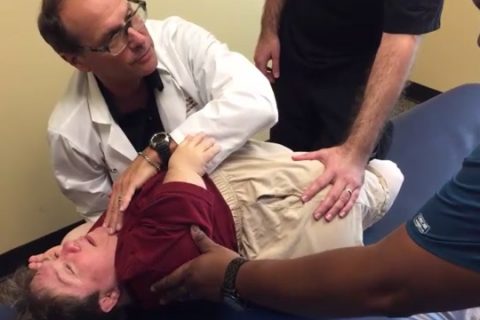
ESTUDIO DE VIDEOCASO: Biomecánica de la maniobra de reposicionamiento de Gans (GRM) para una persona pequeña con VPPB-CP bilateral
Published on: August 18, 2015
El VPPB es una de las causas más comunes de vértigo en niños y adultos. Las maniobras de reposición canalicular (CRM) que utilizan métodos o modificaciones de Epley, Gans o Semont han demostrado ser altamente eficaces para todas las poblaciones, sin importar el protocolo específico. En nuestros blogs anteriores hemos mostrado el tratamiento del VPPB para varios adolescentes con limitaciones físicas derivadas de la espina bífida y la osteogénesis imperfecta.
El paciente en este caso tiene una serie de limitaciones físicas que redujeron significativamente su capacidad para pasar (no puede doblar la cintura) por los protocolos de tratamiento tradicionales sin modificaciones individualizadas. Como se puede ver, con un abordaje de equipo podemos conducirla con éxito a través de las maniobras de reposicionamiento de Gans (GRM); tratando ambos oídos. Evaluamos también los conductos horizontales y la tratamos profilácticamente, siguiendo los protocolos del AIB. Este protocolo asegura que un paciente no haya sufrido una migración horizontal del conducto durante el tratamiento del CP. Los protocolos del AIB no requieren restricciones después del tratamiento, excepto en ciertos casos de pacientes con mayores tasas de recurrencia (menos del 10 % de los pacientes).
Referencias:
1. Badawy et al., (2015), Effect of a Hybrid Maneuver in Treating Posterior Canal Benign Paroxysmal
Positional Vertigo, J. Am. Acad. Audiol, 26:138-144
2. Dispenza, et al., (2012), Comparison of repositioning maneuvers for benign paroxysmal positional vertigo
of semicircular canal: advantages of hybrid maneuver, Am. J. of Otolaryngology, 528-532
3. Roberts RA, Gans RE and Montaudo RL, (2006), Efficacy of a new treatment maneuver for posterior
canal benign paroxysmal positional vertigo, J Am Acad Audiol, 17:598-604
4. Roberts RA, Gans RE, DeBoodt JL, Lister JJ, (2005), Treatment of benign paroxysmal positional vertigo:
necessity of postmanuever restrictions. J Am Acad Audiol 17(8): 598-604